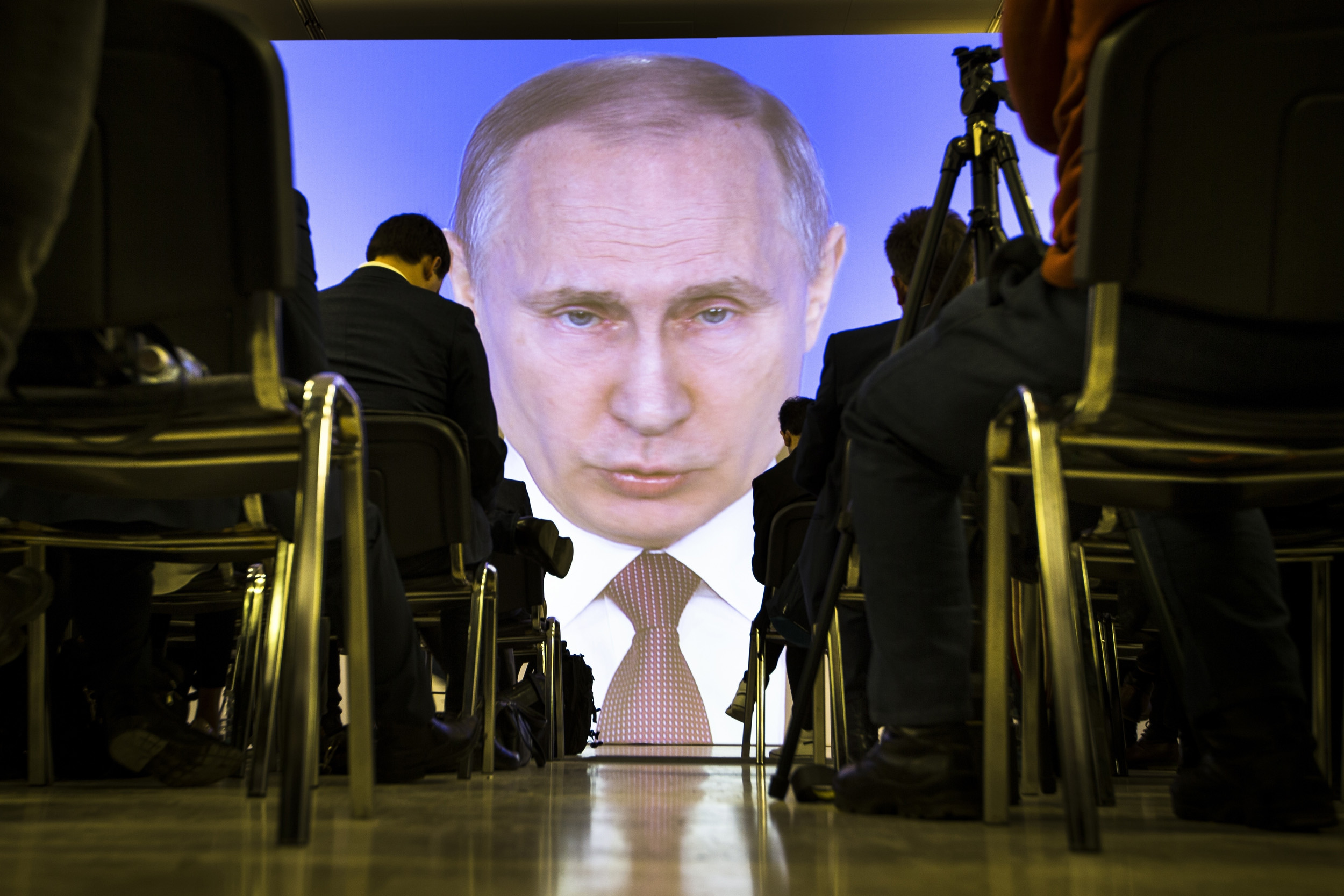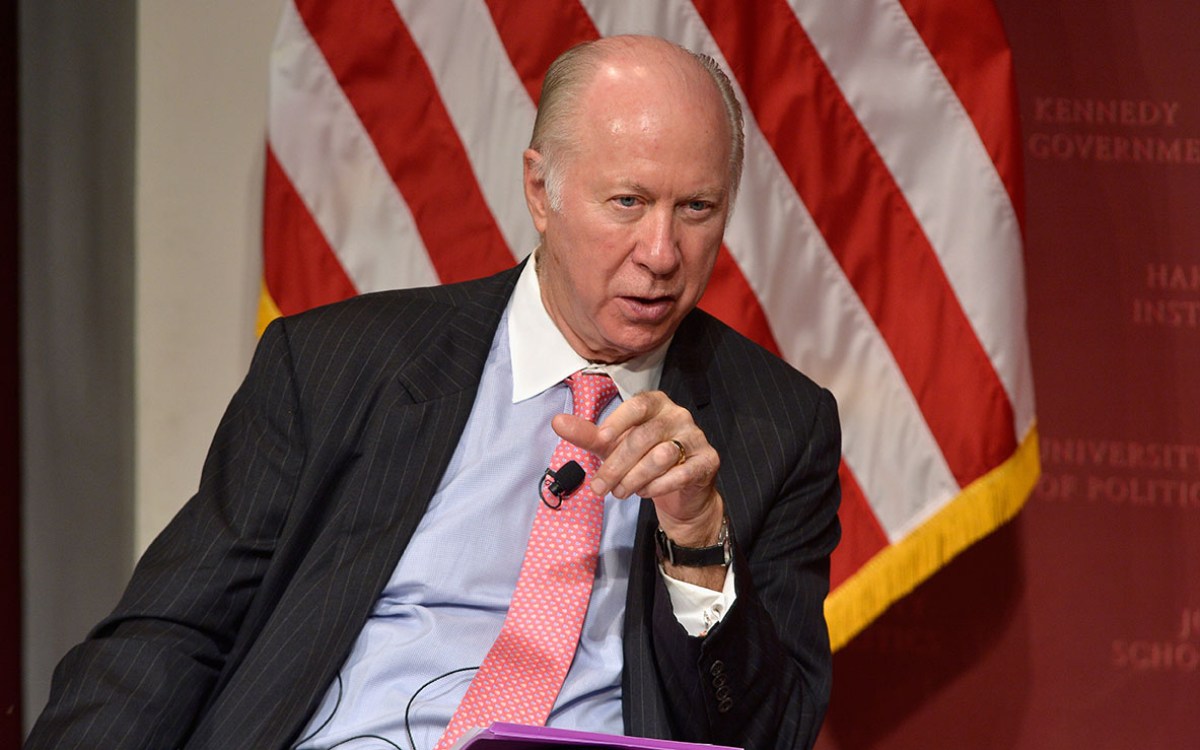
As President Putin boasts about enhancements to Russia’s nuclear arsenal, the Department of Defense’s new review of U.S. nuclear policy and capabilities calls for an end to decades of disarmament efforts and a return to a superpower arms race, not just with Russia but China, as well.
Photo by Alexander Zemlianichenko/AP
Stirrings of a new nuclear arms race
With U.S. and Russia modernizing their arsenals, tensions are rising, reporter says
Reversing a trend toward cutting nuclear stockpiles that dates to the early ’90s, a recent Pentagon report called for ramping up U.S. reliance on nuclear weapons in order to keep pace with an aggressive arms buildup by Russia. Complicating matters, Russian President Vladimir Putin boasted today of having new weapons that could evade U.S. defense systems, taunting that their sophistication would force America to “listen to us now.”
According to the Nuclear Posture Review, the U.S. would spend $1.2 trillion over 30 years to develop more tactical “low-yield” nuclear weapons, would push ahead with plans begun during the Obama administration to replace or modernize existing weapons classes, and for the first time potentially might retaliate against a conventional-weapons attack on its critical infrastructure, such as a massive cyber strike, with a nuclear weapon.
U.S. military officials also are concerned about ambitious nuclear weapons programs in China and in both North Korea and Iran, which are considered wild-card aggressors.
David E. Sanger ’82 is chief Washington correspondent at The New York Times, as well as an adjunct lecturer at Harvard Kennedy School and a longtime Belfer Center affiliate. Over three decades at The Times, he has written extensively about nuclear proliferation, foreign policy, international economics, and the presidency. Sanger spoke with the Gazette about why the U.S. is moving away from disarmament and seemingly returning to a nuclear arms race that most observers thought had ended with the fall of the Soviet Union.
Q&A
David Sanger
GAZETTE: The U.S., under President Barack Obama, and Russia signed the New START treaty in 2010 to reduce an array of weapons and related systems. Both sides met the treaty’s Feb. 5 compliance deadline, and yet here we are, with Secretary of Defense James Mattis and the Department of Defense (DoD) urging new arms escalation. What happened?
SANGER: Some of that was underway beforehand, but it really accelerated in the past five or six years. So two things happened once [Donald] Trump gets elected. I had done that foreign policy interview with him in the campaign with Maggie Haberman, my colleague. And when we discussed nuclear weapons, on the one hand he talked about his uncle who used to teach at MIT who would tell him about the power and reach of nuclear weapons. I don’t think his uncle did very much work with nuclear weapons, but OK.
Secondly, Trump expressed no particular interest in removing nuclear weapons from the center of American defense strategy. And in fact, once in office, he began asking questions like, “If we have all these weapons, why don’t we use them, or at least why don’t we build up their numbers? Why don’t we get back to the numbers we were in?” When I asked him what period of time he’d like to return America to, he said the 1950s. He was thinking manufacturing and so forth, but that was also a period where we had clear nuclear dominance. And I think the image in his head is still one of clear nuclear dominance.
What was new in the Nuclear Posture Review? Two things: First, the insertion of this new language that made the case that we might use a nuclear weapon in response to a devastating attack on infrastructure that doesn’t use a nuclear weapon — a devastating non-nuclear attack. The only way you could get to a devastating non-nuclear attack would be with a cyberattack. And then the question becomes: Would you use a nuclear weapon to deter a massive cyberattack even if the risk was that it would escalate into a nuclear confrontation?
If you think about our cyber adversaries — Russia, China, North Korea, and Iran — three of the four have nuclear weapons of their own, so I’m not sure how credible a threat it is. It was an effort to try to build up some deterrence in the cyber world similar to what we’ve had in the nuclear world. That’s a big subject of the book I’m at work on now. It makes the argument that, unlike nuclear weapons, cyber weapons can be and are used almost every day and, fortunately, nuclear weapons have not been used since Hiroshima and Nagasaki.
The second thing that was notable in the Nuclear Posture Review was Mattis’ language that terrorism is no longer the major thrust of American defense policy, that we’re back to an era of superpower conflict.
GAZETTE: Whose viewpoint does this document reflect, the administration’s or the DoD’s?
SANGER: The Nuclear Posture Review is a document that’s supposed to come out to represent the views across the spectrum of the national security apparatus, but it is published by DoD and usually DoD’s views are dominant. And that’s true across administrations. The president, I’m told, was fully briefed on it. I don’t know how involved he got in the document. I suspect, based on what we know about his tolerance for this kind of detail, probably not that much.
But the concept that we’re in a revised age of conflict of among superpowers is true across three documents that the new administration has brought out: the National Security Strategy, which comes from the White House and came out in December; a new Defense Strategy that came out from the Pentagon in January; and this document, which came out right behind it. The three were drafted, if not together, then with each one in mind. You’ll find the language common in all three. The documents are in sync, though they’re not in sync with what the president said publicly.
GAZETTE: President Obama signed a $1 trillion modernization program before he left office. Was that sufficient, or is Mattis saying more needs to be done?
SANGER: Obama never signed the $1 trillion appropriation. We all knew that there were Office of Management and Budgets reports, there were Congressional Budget Office reports that said: If, over 30 years, you’re going to really revise the nuclear fleet, it’s going to cost you $1 trillion. And then three or four months ago, that estimate got up to $1.2 trillion, and a lot of people I talk to think the real number is closer to $1.6 trillion. The big decisions that have to be made aren’t about the weapons, which are comparatively cheap, but about replacing the delivery vehicles. So that means new bombers (very expensive), a new class of submarines (wildly expensive), and then remaking our falling-apart ground-based missile system. There was some expectation that had Hillary Clinton gotten elected we might abandon the ground-based system. It’s highly vulnerable; you can’t move it, so your adversaries know exactly where it is. It’s leaky, leaky as in water pouring into it. It’s got a demoralized force of people sitting there using 5-inch floppy disks. So the question was: Do you pour huge money into remaking it, or do you turn these silos across the West into some really great science experiments? (Laughs.)
GAZETTE: How much of what’s proposed is likely to move forward?
SANGER: There’s a lot of it that’s in Trump’s budget, but 30-year programs usually start with a prototype — bomber systems and so forth. The review also calls for the development of two new low-yield weapons — not wildly expensive — but that shows we’re in a new, different kind of arms race, as [Times reporter] Bill Broad and I indicated, that has more to do with capability than numbers.
GAZETTE: With so many economic problems, why is Russia rushing to modernize its forces and skirt or violate treaty limits? It can’t go head-to-head or surpass the U.S. from a technological or quantity standpoint. Do the Russians see some vulnerability that they hope to exploit?
SANGER: If you’re Russia and you are looking for a way that you’re going to compete and be a disrupter and stay in the center of it all, you’re looking to do cheap things that you think will give you maximum leverage for your ruble. And we’ve seen three by Putin. One is, he has gone into the Russian-speaking parts of neighboring countries like Ukraine or gone into Syria where he’s been more successful than we thought, with a relatively small and largely proxy force. Second, he’s used cyber, most notably in the U.S. election, but also in Ukraine and other places, and against the Europeans — which is also cheap. And third, there’s nuclear, which while not super cheap is not wildly expensive compared to increasing the size of your military forces, and so forth. So I think he sees these as ways to put Russia back into the game that the Soviet Union was in. Are these efforts going to get to Soviet Union-like levels? Probably not. But modernizing in some ways is less expensive than getting into a numerical arms race.
GAZETTE: Is the era of nuclear arms control over? In hindsight, was the New START a failure, and, if so, why? Is it all because of Putin?
SANGER: No, there’s a little bit on us. The Comprehensive Nuclear Test-Ban Treaty was negotiated more than 20 years ago. President Bill Clinton put it up for a vote without having his votes lined up. It got defeated. We followed all of its provisions, but we were not a signatory to it. The Obama administration, every year, would promise that it was going to bring back the Comprehensive Test-Ban Treaty and get it pushed through Congress. Vice President Joe Biden said it in a speech, Obama said it periodically, but it was always this sort of a long-term goal. After the Democrats lost control of Congress, it was a lost cause. I think our reluctance to ratify it put a bit of a damper on things.
The New START treaty passed, but the price that Obama had to pay to get it through was paying a lot of money to refurbish the nuclear laboratories and the weapons programs. They needed to be modernized, and some of those nuclear weapons laboratories were an environmental disaster waiting to happen. They had facilities that, some of them, hadn’t been remade in a serious way since the ’40s and ’50s, and there was a possibility of leakage of materials, and the security was bad. Some of that money clearly needed to get spent, and that’s part of the difficulty when you go down the line of building nuclear weapons. You end up spending a huge amount of money protecting them, keeping them safe, making sure they can’t be hacked, and making sure they can’t be stolen.
GAZETTE: Is the U.S. reversal on nuclear buildup a victory for Russia, China, and others in that they’re calling the tune, getting us to spend time and money on things we don’t really want to spend them on?
SANGER: That’s also what we did to them during the Reagan era. I think that’s right. But I’m arguing now in this new book that the real arms race is in cyber, which is vastly cheaper to do, and people are doing more with it because they can use it every day. Its results can’t be immediately seen. We haven’t figured out a good way to deter it. In many ways, it’s the opposite of a nuclear weapon. People are using cyber now to try to slow another country’s nuclear ambitions. That can be destabilizing because if you think that my cyber weapons may be in your nuclear program, your command and control, you might be more tempted to use those weapons more quickly to understand whether or not they’ve been attacked or to get out ahead of a cyberattack. So there is a school of thought that it actually makes it more dangerous, since your temptation to use the weapons is higher.
GAZETTE: Alarmingly, the review refers to Russia’s development of an autonomous nuclear torpedo that could hit the West Coast of the U.S. and leave it uninhabitable. How does Trump’s oddly solicitous view of Putin and Russia complicate DoD’s efforts to respond to such threats, and, if so, what are our options?
SANGER: That’s the “doomsday” torpedo. The rest of the national security establishment, rightly or wrongly, is progressing along on this concept that we need to build up against Russian nuclear capability, a new Russian cyber capability, a new Russian anti-satellite capability, and a new Russian willingness to go off into places like Syria and Ukraine.
GAZETTE: But these are long-range plans that extend far beyond four- and eight-year presidential terms and require that we anticipate and safeguard against the worst possible outcomes.
SANGER: That’s right. And we have to work out a containment strategy. Ash Carter, now the director at the Belfer Center, said in a recent interview with Politico that he, for the first time, started up a war-planning exercise and that he once again had to plan for war with Russia. I think that was very prudent because we needed a containment strategy. The only one missing from this strategy is the president himself. If you go back and you look at the national security speeches he’s given, they’ve been on Iran, they’ve been on North Korea, they’ve been on terrorism. He has never given us a comprehensive or even more than a glancing reference that it’s a problem. He has said, and said in the interviews that Maggie and I did with him during the campaign, “I don’t see why we and Russia can’t be friends,” and so on. His wording is out of sync with his administration’s own policies, including these three fascinating documents, the National Security Strategy, the Defense Review, and the Nuclear Posture Review.
The other day, press secretary Sarah Huckabee Sanders said, “We’ve done more to push back on the Russians than the Obama administration did in their eight years.” This is the bizarre disconnect. The oddity here is that the ship of state is being steered into a containment mode against Russia without the active participation of the captain. It’s plugging off in that direction. President Trump has endorsed much larger military budgets, but has never discussed why you need that much more. Clearly, Russia is a big part of that. And what’s oddly absent here is a president sitting down and walking us through the theory of this the way Dwight Eisenhower did when he was president during a big buildup; the way John Kennedy did, sometimes in a misleading way with the missile gap, sometimes in a very honest way with the Cuban Missile Crisis; the way Richard Nixon did. Trump just has not sat down to give us the rationale for a reversal of 20 or 25 years of a reduction in the centrality of nuclear weapons. He’s left it to Secretary Mattis and, to a lesser degree, National Security Adviser H.R. McMaster.
GAZETTE: Where do you anticipate this is headed?
SANGER: I think we are not going to see a race that involves numbers; we are going to see a race that involves quality and capability. I think that you are going to see a movement to much more cyber competition because it does not have the destabilizing, huge risk effects of nuclear weapons. The difference between cyber weapons and nuclear weapons is you can use cyber weapons and largely get away with it, as the Russians did against us and as we have used against others. Meanwhile, you’ll see the U.S. move toward this much larger buildup. The hope that the U.S. has is that in doing this buildup, it is creating some leverage to begin to reopen negotiations with the Russians. But I haven’t seen any effort yet on the part of this administration to reopen those negotiations. Maybe it’s too early.
This interview has been edited for clarity and length.




